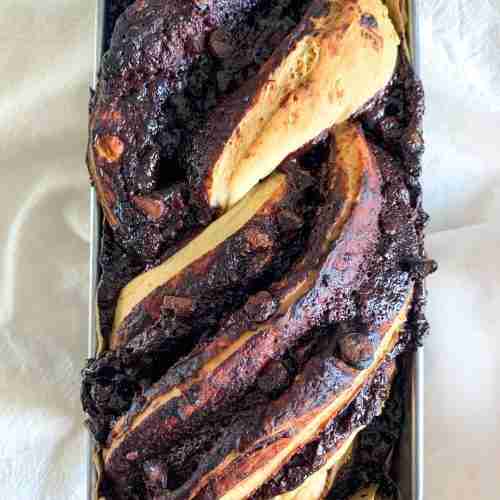
Sourdough Chocolate Babka
Sourdough chocolate babka is a sweet, enriched dough that's filled with a smooth homemade chocolate filling, rolled, and braided before baking. It's a simple bread that will make your house smell as amazing as the bread tastes!
Ingredients
- 1/2 cup fed sourdough starter (feed starter 4-12 hours before using)
- 1 cup milk
- 1 tsp salt
- 6 Tbsp melted butter
- 1 Tbsp raw honey
- 3 1/2 cups all-purpose flour
Filling
- 1/4 cup unsweetened cocoa powder
- 6 Tbsp butter (salted)
- 1/4 cup raw honey
- 1/2 cup semi-sweet chocolate chips (chopped)
Instructions
Prepare Your Sourdough Starter
- Feed your starter 4-12 hours before starting this recipe. I recommend feeding it a 2:1 ratio of flour to water. It needs to be active and bubbly to begin this recipe.
Make the Babka Dough
- In a large mixing bowl, add in sourdough starter, milk, salt, melted butter, and honey then stir until combined.
- Add flour and stir until a shaggy dough forms. Use your hands to bring the dough into a ball. If this isn’t working add 1-2 Tablespoons of extra milk to help but don’t do this if not necessary.
- Turn dough out on the counter. Knead dough by hand or with a mixer that has a dough attachment for 3 minutes. Only use a dusting of flour if the dough is sticking.
- Cover dough with a lid loosely, a damp kitchen towel, or seran wrap and let it sit at room temperature on the counter for 12 hours until it doubles in size. (See notes for tips and help!)
Make the Chocolate Filling
- When the bulk ferment ends, make your filling by placing the butter for the filling in a medium-sized pot on medium heat.
- Add in honey and cocoa powder stir to combine. Once everything is combined and the butter is melted, take off heat and set aside.
Shape the Babka
- Once bulk fermentation is complete your dough should have doubled in size. Punch it down to deflate then place the dough on the counter. No flour is needed.
- Roll out dough on a lightly floured surface into a rectangle approximately 10" x 14".
- Pour filling over rolled-out dough and use a butter knife to evenly spread the filling over the entire rectangle.
- Sprinkle roughly chopped chocolate chips over the filling.
- Starting at the shorter 10" side of the rectangle begin to roll the dough into a log tightly. Pinch the seam together with your hands at the end.
- IMPORTANT: Now place the log on a piece of parchment paper that’s already sized to fit a 9x5” loaf pan. This will make transporting easy.
- Now cut the log down the center 3/4 of the way down the middle longwise so that 1/4 is still at the top uncut.
- Twist the cut sides around each other like you’re doing a 2-strand braid.
- Place the shaped babka on the parchment in a loaf pan. Cut down the excess parchment.
- Cover the pan with a separate slice of parchment paper and then a dry kitchen towel. Let it rise for 3-4 hours at room temperature. (See notes for help and tips!)
Bake the Babka
- After the babka has finished proofing, preheat the oven to 375 degrees.
- Place loaf pan on a sheet pan incase any chocolate spills over the sides. Bake for 45-50 minutes.
- Let babka cool in the pan for 5 minutes then take it out using the parchment paper that it’s on. Let cool rest of the way on a wire rack. Enjoy!
Notes
IMPORTANT INFORMATION!
- Make sure your starter is active! BEFORE YOU GET STARTED: Feed your starter 4-12 hours before starting this recipe. I recommend feeding it a 2:1 ratio of unbleached flour to filtered water to get the same results as I do when you make this recipe. Example: Feed 1 cup flour + 1/2 cup water and let the starter sit on the counter at room temperature until it's bubbly and has grow in the jar. Your starter needs to be active, bubbly, and a thicker consistency to begin this recipe.
- Let the dough bulk ferment for 12 hours. It is important to let your dough bulk ferment for the full 12 hours. It should double in size and have air bubbles in it.
- Place the dough in a warm spot to rise. For both the bulk ferment and the second rise after shaping, your dough needs to be at room temperature in a non-drafty place.
- If your dough doesn't look like it's doing anything halfway through the rises, you need to place it in a slightly warmer area. This can be in a turned-off oven with the light on and oven door open, or you can slightly warm the oven to about 75-80 degrees Fahrenheit, then turn it off and place your dough inside with the door shut. Never leave the oven on, even on the keep warm setting, with fermenting dough inside. Your dough, for both rises, needs to double.
- If your dough doesn't double in size even in the warmer area, there is a problem with your starter. It is too weak to ferment the dough even in a warm environment. To fix this, you will want to leave your starter out on the counter for 2 days and feed it every 12 hours a 2:1 ratio of unbleached flour to filtered water. For example, 1 cup unbleached flour + 1/2 cup filtered (or bottled) water. This will strengthen the cultures in your starter to give you fluffy baked breads and goods. After the 2 days you can go back to feeding it like usual (once a week if stored in the fridge or once a day if stored on the counter).